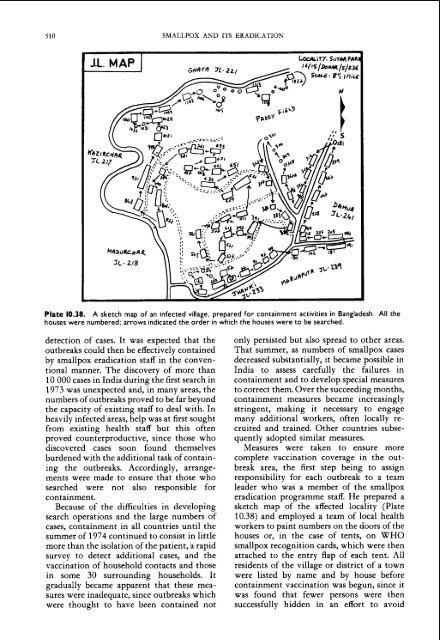smallpox eradication - libdoc.who.int - World Health Organization
smallpox eradication - libdoc.who.int - World Health Organization
smallpox eradication - libdoc.who.int - World Health Organization
You also want an ePaper? Increase the reach of your titles
YUMPU automatically turns print PDFs into web optimized ePapers that Google loves.
510 SMALLPOX AND ITS ERADICATION<br />
Plate 10.38. A sketch map of an infected village, prepared for containment activities in Bangladesh. All the<br />
houses were numbered; arrows indicated the order in which the houses were to be searched.<br />
detection of cases. It was ex~ected that the<br />
outbreaks could then be effectively contained<br />
by <strong>smallpox</strong> <strong>eradication</strong> staff in the conventional<br />
manner. The discovery of more than<br />
10 000 cases in India durine " the first search in<br />
1973 was unexpected and, in many areas, the<br />
numbers of outbreaks proved to be far beyond<br />
the capacity of existing staff to deal with. In<br />
heavily infected areas, help was at first sought<br />
from existing health staff but this often<br />
proved ~oun~er~roductive, since those <strong>who</strong><br />
discovered cases soon found themselves<br />
burdened with the additional task of containing<br />
the outbreaks. Accordingly, arrangements<br />
were made to ensure that those <strong>who</strong><br />
searched were not also responsible for<br />
containment.<br />
Because of the difficulties in developing<br />
search operations and the large numbers of<br />
cases, containment in all countries until the<br />
summer of 1974 continued to consist in little<br />
more than the isolation of the patient, a rapid<br />
survey to detect additional cases, and the<br />
vaccination of household contacts and those<br />
in some 30 surrounding households. It<br />
gradually became apparent that these measures<br />
were inadequate, since outbreaks which<br />
were thought to have been contained not<br />
only persisted but also spread to other areas.<br />
That summer, as numbers of <strong>smallpox</strong> cases<br />
decreased substantially, it became possible in<br />
India to assess carefully the failures in<br />
containment and to develop special measures<br />
to correct them. Over the succeeding months,<br />
containment measures became increasingly<br />
stringent, making it necessary to engage<br />
many additional workers, often locally recruited<br />
and trained. Other countries subsequently<br />
adopted similar measures.<br />
Measures were taken to ensure more<br />
complete vaccination coverage in the outbreak<br />
area, the first step being to assign<br />
responsibility for each outbreak to a team<br />
leader <strong>who</strong> was a member of the <strong>smallpox</strong><br />
<strong>eradication</strong> programme staff. He prepared a<br />
sketch map of the affected locality (Plate<br />
10.38) and employed a team of local health<br />
workers to pa<strong>int</strong> numbers on the doors of the<br />
houses or, in the case of tents, on WHO<br />
<strong>smallpox</strong> recognition cards, which were then<br />
attached to the entry flap of each tent. All<br />
residents of the village or district of a town<br />
were listed by name and by house before<br />
containment vaccination was begun, since it<br />
was found that fewer persons were then<br />
successfully hidden in an effort to avoid
















